新概念第三册第18课共16页文档
- 格式:ppt
- 大小:2.47 MB
- 文档页数:16
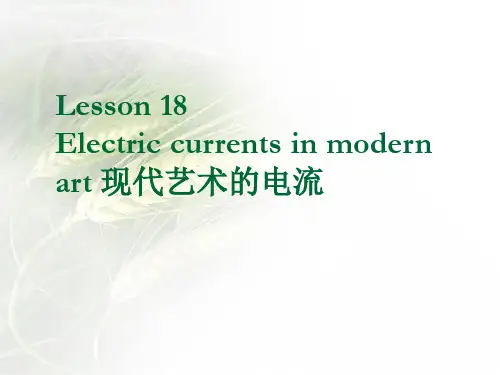
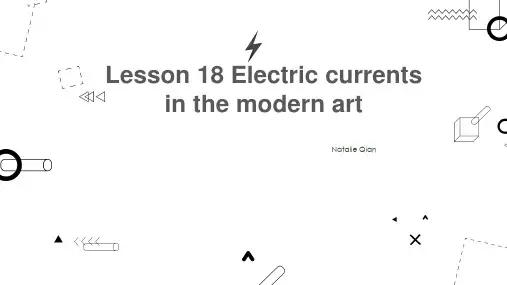
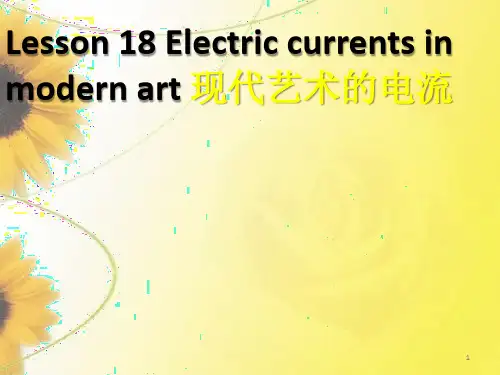
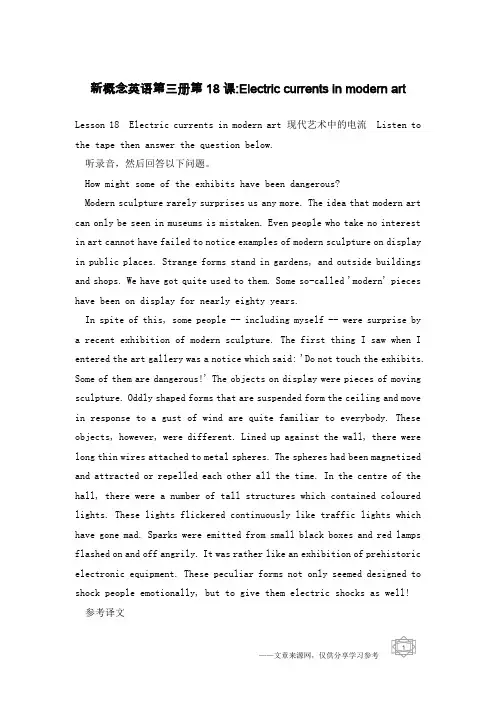
新概念英语第三册第18课:Electric currents in modern artLesson 18 Electric currents in modern art 现代艺术中的电流 Listen to the tape then answer the question below.听录音,然后回答以下问题。
How might some of the exhibits have been dangerous?Modern sculpture rarely surprises us any more. The idea that modern art can only be seen in museums is mistaken. Even people who take no interest in art cannot have failed to notice examples of modern sculpture on display in public places. Strange forms stand in gardens, and outside buildings and shops. We have got quite used to them. Some so-called 'modern' pieces have been on display for nearly eighty years.In spite of this, some people -- including myself -- were surprise by a recent exhibition of modern sculpture. The first thing I saw when I entered the art gallery was a notice which said: 'Do not touch the exhibits. Some of them are dangerous!' The objects on display were pieces of moving sculpture. Oddly shaped forms that are suspended form the ceiling and move in response to a gust of wind are quite familiar to everybody. These objects, however, were different. Lined up against the wall, there were long thin wires attached to metal spheres. The spheres had been magnetized and attracted or repelled each other all the time. In the centre of the hall, there were a number of tall structures which contained coloured lights. These lights flickered continuously like traffic lights which have gone mad. Sparks were emitted from small black boxes and red lamps flashed on and off angrily. It was rather like an exhibition of prehistoric electronic equipment. These peculiar forms not only seemed designed to shock people emotionally, but to give them electric shocks as well! 参考译文现代雕塑不再使我们感到惊讶了。

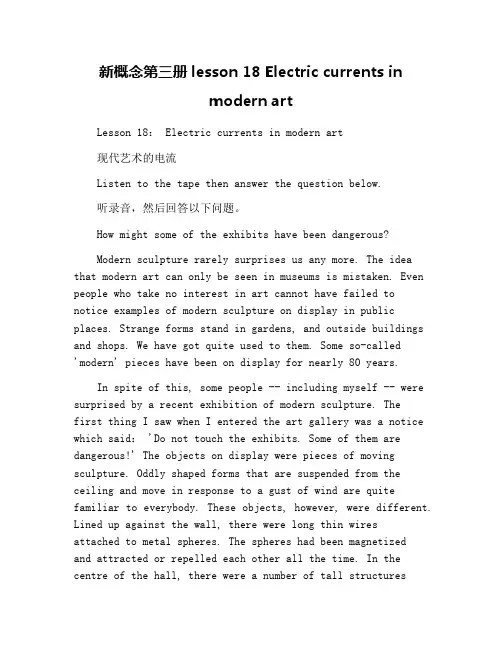
新概念第三册lesson 18 Electric currents inmodern artLesson 18: Electric currents in modern art现代艺术的电流Listen to the tape then answer the question below.听录音,然后回答以下问题。
How might some of the exhibits have been dangerous?Modern sculpture rarely surprises us any more. The idea that modern art can only be seen in museums is mistaken. Even people who take no interest in art cannot have failed tonotice examples of modern sculpture on display in public places. Strange forms stand in gardens, and outside buildings and shops. We have got quite used to them. Some so-called'modern' pieces have been on display for nearly 80 years.In spite of this, some people -- including myself -- were surprised by a recent exhibition of modern sculpture. Thefirst thing I saw when I entered the art gallery was a notice which said: 'Do not touch the exhibits. Some of them are dangerous!' The objects on display were pieces of moving sculpture. Oddly shaped forms that are suspended from the ceiling and move in response to a gust of wind are quite familiar to everybody. These objects, however, were different. Lined up against the wall, there were long thin wiresattached to metal spheres. The spheres had been magnetizedand attracted or repelled each other all the time. In the centre of the hall, there were a number of tall structureswhich contained coloured lights. These lights flickered continuously like traffic lights which have gone mad. Sparks were emitted from small black boxes and red lamps flashed on and off angrily. It was rather like an exhibition of prehistoric electronic equipment. These peculiar forms not only seemed designed to shock people emotionally, but to give them electric shocks as well !New words and expressions 生词与短语currentn. 电流sculpturen. 雕塑mistakenadj. 错误的galleryn. 美术馆exhibitn. 展品,陈列品oddlyadv. 古怪的attachv. 连,系spheren. 球体magnetizev. 使磁化repelv. 排斥flickerv. 闪烁emitv. 放射flashv. 闪光prehistoricadj. 史前的,老掉牙的electronicadj. 电子的peculiaradj. 奇异的shockv. 令人震惊,刺激人emotionallyadv. 事情上本文参考译文现代雕塑不再使我们感到惊讶了。
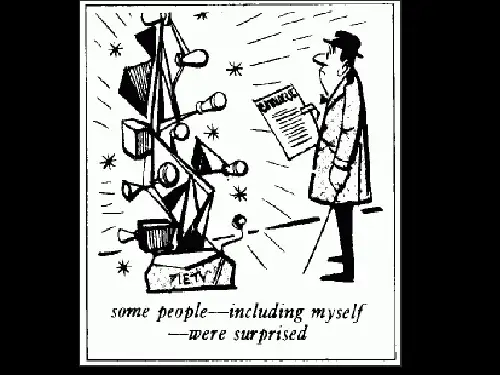
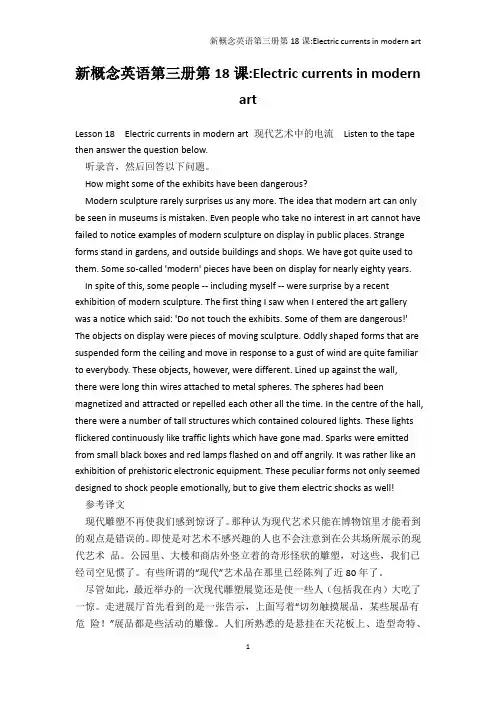
新概念英语第三册第18课:Electric currents in modernartLesson 18 Electric currents in modern art 现代艺术中的电流Listen to the tape then answer the question below.听录音,然后回答以下问题。
How might some of the exhibits have been dangerous?Modern sculpture rarely surprises us any more. The idea that modern art can only be seen in museums is mistaken. Even people who take no interest in art cannot have failed to notice examples of modern sculpture on display in public places. Strange forms stand in gardens, and outside buildings and shops. We have got quite used to them. Some so-called 'modern' pieces have been on display for nearly eighty years.In spite of this, some people -- including myself -- were surprise by a recent exhibition of modern sculpture. The first thing I saw when I entered the art gallery was a notice which said: 'Do not touch the exhibits. Some of them are dangerous!' The objects on display were pieces of moving sculpture. Oddly shaped forms that are suspended form the ceiling and move in response to a gust of wind are quite familiar to everybody. These objects, however, were different. Lined up against the wall, there were long thin wires attached to metal spheres. The spheres had been magnetized and attracted or repelled each other all the time. In the centre of the hall, there were a number of tall structures which contained coloured lights. These lights flickered continuously like traffic lights which have gone mad. Sparks were emitted from small black boxes and red lamps flashed on and off angrily. It was rather like an exhibition of prehistoric electronic equipment. These peculiar forms not only seemed designed to shock people emotionally, but to give them electric shocks as well!参考译文现代雕塑不再使我们感到惊讶了。
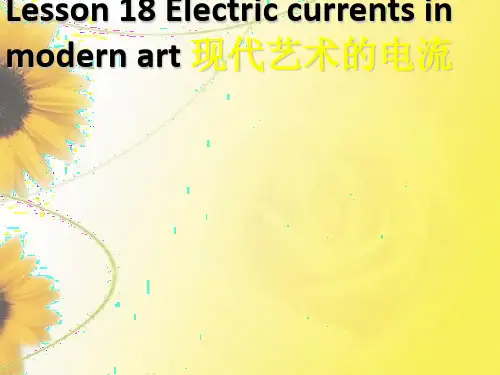
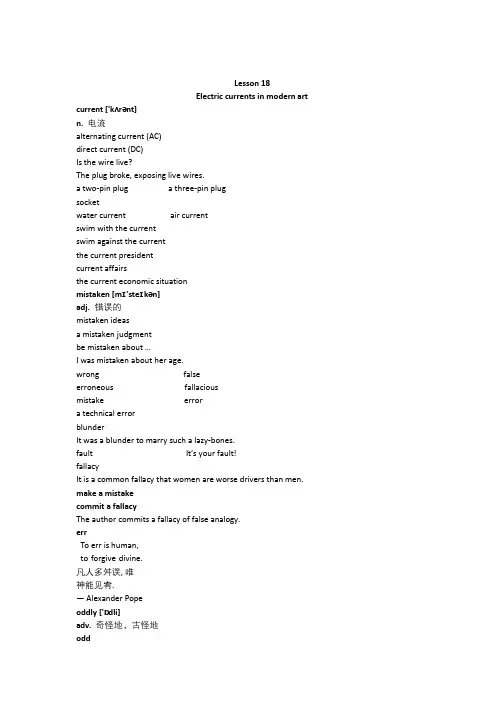
Lesson 18Electric currents in modern art current ['kʌrənt]n. 电流alternating current (AC)direct current (DC)Is the wire live?The plug broke, exposing live wires.a two-pin plug a three-pin plugsocketwater current air currentswim with the currentswim against the currentthe current presidentcurrent affairsthe current economic situationmistaken [mɪ'steɪkən]adj. 错误的mistaken ideasa mistaken judgmentbe mistaken about …I was mistaken about her age.wrong falseerroneous fallaciousmistake errora technical errorblunderIt was a blunder to marry such a lazy-bones.fault It’s your fault!fallacyIt is a common fallacy that women are worse drivers than men. make a mistakecommit a fallacyThe author commits a fallacy of false analogy.errTo err is human,to forgive divine.凡人多舛误, 唯神能见宥.— Alexander Popeoddly ['ɒdli]adv. 奇怪地,古怪地oddWhat an odd man he is!an odd numberan even numberstrange unusualpeculiara peculiar smella most peculiar storybe peculiar to …Pandas are peculiar to China.weirdI heard some weird noises coming from outside.eccentricOur neighbor is an eccentric old lady who has about 25 cats.bizarre outlandishShe came to the party wearing a bizarre / an outlandish costume and a blond wig.attach [ə'tætʃ]v. 连上,系上,贴上,附加上attach … to …attach a photo to the formattach a rope to the branchThey attached a number of conditions to the agreement.China attaches great importance / significance to agriculture.She attaches great value to financial independence.sphere [sfɪə(r)]n. 球体;领域in the scientific / political / cultural / educational … sphere / area / field / world / realm / domain atmospherehemispherethe northern / southern / eastern / western hemisphererepel [rɪ'pel]v. 排斥Oil repels water.attractHis behavior repels me.The food repels my stomach.be repelled by …I was repelled by his behavior.repellentrepellent smell / behaviorrepel repellentrepulse repulsiverevolt revoltingdisgust disgustingYou would not be able to understand why some people find it repulsive.“pel” = pushrepel compel / impelbe / feel compelled to dobe / feel impelled to doexpel propelflicker ['flɪkə(r)]v. 闪烁The candle flickered in the wind.twinkleTwinkle, twinkle, little star, like a diamond in the sky.— Jane Taylorsparkle glitterThe diamond sparkled in the sunlight.All that glitters is not gold.— William Shakespeareflasha flash of lightninga flash in the panHis first novel proved to be a flash in the pan. He never wrote another.emit [ɪ'mɪt]v. 放射,发射Fireflies emit light but not heat.give off dischargelaunchlaunch a rocket / missile / satelliteemit: “e ”(out) + “mit ”(se nd)submit: “sub ”(under) + “mit ”transmit: “trans ” (across)+ “mit ”sexually transmitted diseasesThe US open will be transmitted live via satellite.vomit: “vo ”(eat) + “mit ”omit: “o ”=“ob ”(away) + “mit ”rarely seldomalmost never hardly everThough he owned a large car, he hardly ever used it, preferring always to go on foot. Rarely / Seldom does modern sculpture surprise us any more.astonishdisturbremindconfuseconvinceHis reaction made me feel deeply disappointed.→His reaction deeply disappointed me.What he said made me totally confused.→What he said totally confused me.The idea that modern art can only be seen in museums is mistaken.When reports came into London Zoo that a wild puma had been spotted forty-five miles south of London, they were not taken seriously.The idea is mistaken that modern art can only be seen in museums.圆周句(掉尾句)That all great art has this power of suggesting a world beyond is undeniable.It is undeniable that all great art has this power of suggesting a world beyond.Although Tchaikovsky himself thought of the Pathetic Symphony as his crowning masterpiece, the premiere on October 28th 1893 in St. Petersburg proved a disappointment.Even people who take no interest in art cannot have failed to notice examples of modern sculpture on display in public places.be interested in …take … interest in …take an interest in …take no interest in …take little interest in …take a lot of interest in …Kidnappers are rarely interested in animals, but they recently took considerable interest in Mrs. Eleanor Ramsay's cat.take pride in ...You should take pride in your work.take pleasure / delight in ...College students seem to take pleasure / delight in practical jokes.take comfort in ...I know she goes out a lot at night, but I take comfort in the fact that she's always with friends. take pity on ...I took pity on the beggar and gave him some change.cannot have failed to notice …must have noticed …Cats never fail to fascinate human beings.“on + 名词”表示处于某种状态on display / show / exhibitionThe house is on sale.The workers are on strike.I’m here on vacation.I’m here on business.The nurse is on call 24 hours a day.Strange forms of sculpture stand in gardens, and outside buildings and shops.be / get / become used to(介词) …“We'll get used to that Bill,” said the vicar.be / get / become accustomed to(介词) …We have got quite accustomed to them. (A)Read a gas meter. (B) Start a camp fire. (C)Get gas for his car. (D) Cook some food.M: I’m not accustomed to using a gas stove.W: It’s simple. Just turn the knob until the burner lights then adjust the flame.Q: What is the man going to do?Answer: (D) Cook some food.be / get / become familiar with …We have got quite familiar with them.be adapted to(介词) …I am adapted to Beijing’s dry climate.so-calledWhere are your so-called friends now?—including myself——as well as myself——no less than myself—The first thing I saw when I entered the art gallery was a notice which said: 'Do not touch the exhibits. Some of them are dangerous!'say v. 上面写着…The sign says ‘Keep Out’.What did the letter say?My watch says four o’clock.A tiny asterisk conducted me to a footnote at the bottom of the page. It said: 'This service has been suspended.'go v. 一句话一个故事是怎么说的;一首歌是怎么唱的As the old saying goes, ‘look before you leap’.The story goes that the prince was turned to a frog.How does the song go?Keep away from the exhibits.a strangely shaped carrotShe has a perfectly shaped figure.heart-shapedpear-shapedV-shapedbe suspended from ..hang from …His driver’s license was suspended.in response to …The president stepped down in response to public pressure.a gust of winda flash of lightninga peal of thundera fit of coughinga round of applausepeals / gales of laughterbe familiar with …be familiar to …Many readers are familiar with the name Harry Potter.The name Harry Potter is familiar to many readers.Lined up against the wall, there were long thin wires attached to metal spheres.line sth. upThe books are lined up on the shelf.line up Line up, everybody!cut in lineattach sth. to sth.造句:在桌上排列着一些崭新的(brand-new) 电脑,而电脑上又连着(connect) 打印机(printer)。
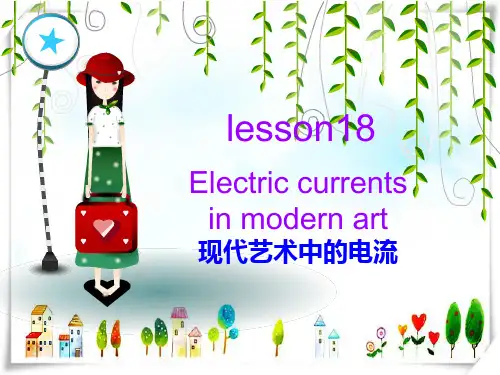
New concept English Lesson 18Electric currents in modern art现代艺术中的电流electric currents,电流(s不能少)How might some of the exhibits have been dangerous?有一些展览可能是危险的,是怎么回事?Modern sculpture rarely surprises us any more.现在雕塑不再使我们感到惊讶了sculpture,雕塑rarely,罕有,很少,不常any more,(常用于否定句和疑问句末)再也(不),(不)再The idea that modern art can only be seen in museums is mistaken.现代艺术只能在博物馆里看到的想法是错误的museum,博物馆mistaken,错误的Even people who take no interest in art cannot have failed to notice examples of modern sculpture on display in public places.即使对艺术没兴趣的人,也不能不注意到公共场所的现代雕塑的展品take no interest in,不感兴趣cannot+have+过去分词,表示对现在的推测,翻译为:不可能……could not+have+过去分词,表示对过去的推测,翻译为:过去不可能……Strange forms stand in gardens, and outside buildings and shops.立在公园里、建筑物以及商店的外面的奇形怪状的雕塑We have got quite used to them.我们对它们已经很熟悉了get used to,开始习惯了Some so-called 'modern' pieces have been on display for nearly eighty years.一些所谓的“现代”雕塑品,已经展示了将近80年so-called,(表示不认同)所谓的;号称……的on display,展出In spite of this, some people-including myself-were surprised by a recent exhibition of modern sculpture.尽管如此,某些人-包括我-还是被最近的一个现代雕塑展惊到了In spite of this,尽管如此The first thing I saw when I entered the art gallery was a notice which said:'Do not touch the exhibits.当我走进艺术品展览馆时,看见的第一个东西是一个告示,上面写着:“不要触碰展品gallery,陈列室,画廊,展览馆Some of them are dangerous!'中间有一些有危险“The objects on display were pieces of moving sculpture.展览的展品是一些活动的雕塑Oddly shaped forms that are suspended from the ceiling and move in response to a gust of wind are quite familiar to everybody.奇形怪状的雕塑吊在天花板,随着一阵阵风晃动,对每个人来说都是司空见惯Oddly,古怪的suspended from,从(顶棚)垂下ceiling,顶棚,天花板in response to,相应,对…有反应a gust of wind,一阵风familiar to,熟悉These objects, however, were different.然而,这些展品不同Lined up against the wall, there were long thin wires attached to metal spheres.有些长长的细线靠墙排列着,连接到金属球attach to附属于spheres球The spheres had been magnetized and attracted or repelled each other all the time.这些球已经被磁化,互相之间不停地吸引和排斥magnetize,磁化attract,吸引repel,排斥In the centre of the hall, there were a number of tall structures which contained coloured lights.大厅的中央,有一些高大的展品,带着彩色的灯These lights flickered continuously like traffic lights which have gone mad.这些灯不停的闪烁,像失控的红绿灯flicker,闪烁mad,发疯的go mad,发疯,失控Sparks were emitted发射 from small black boxes and red lamps flashed on and off angrily.火花从小黑盒子里发射出来,红灯愤怒地开关着(忽明忽暗)emit,发射on and off,断断续续It was rather like an exhibition of prehistoric electronic equipment.这很像老旧的电子仪器展览会prehistoric,史前的,远古的These peculiar forms not only seemed designed to shock people emotionally, but to give them electric shocks as well! 这些奇怪的雕塑看起来不仅设计成要给人们感情上的刺激,而且还要给他们身体上的电击peculiar,奇怪的shock,使震惊,使惊愕emotionally,给人感情上的……(动作)。